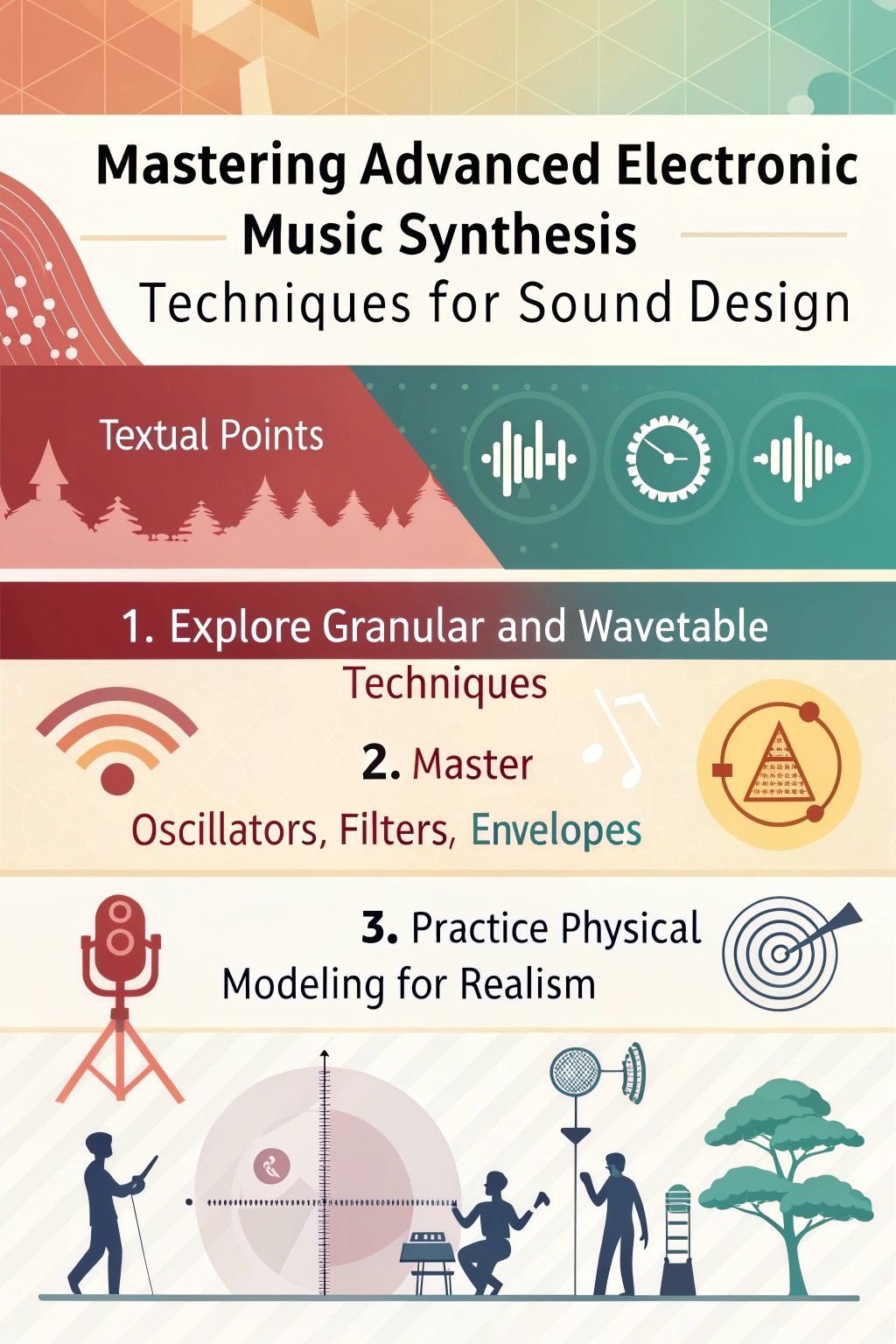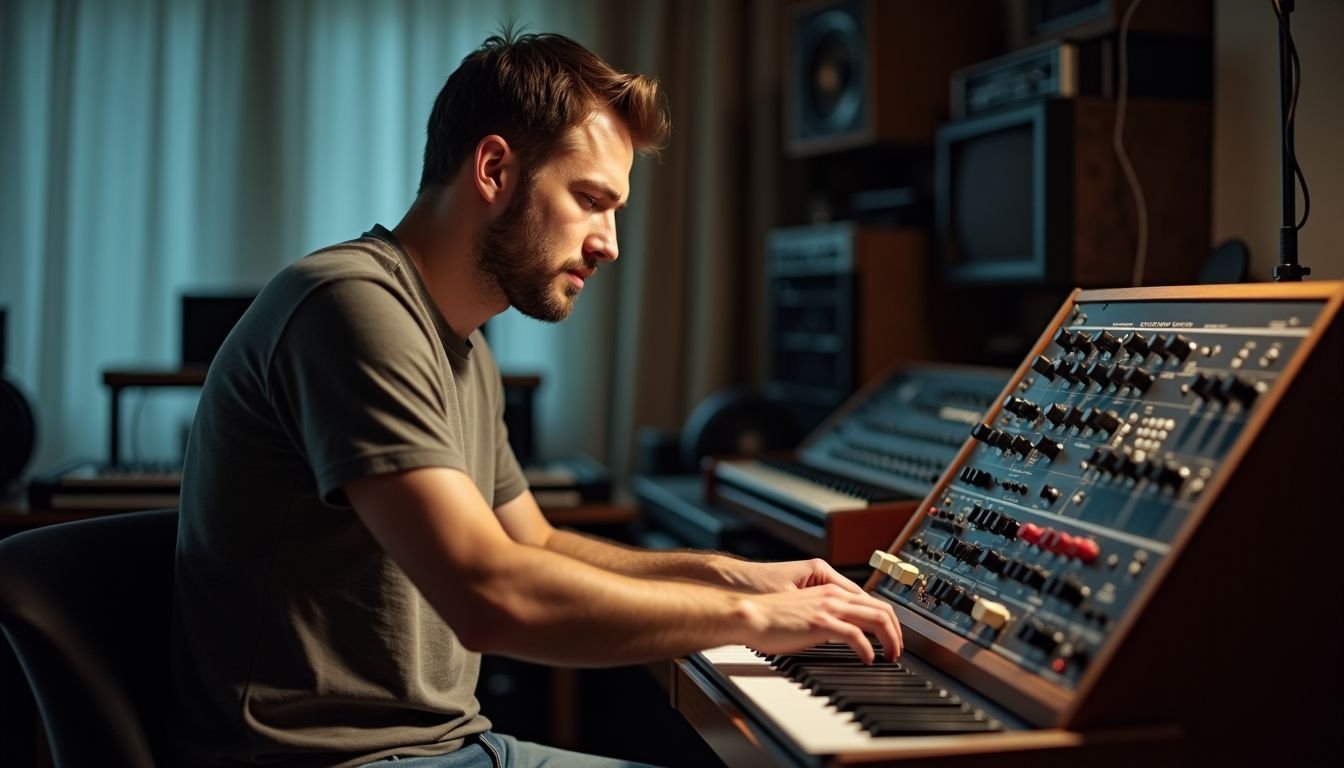
Many music producers struggle to make their tracks stand out. A key fact is mastering advanced electronic music synthesis techniques can change this. This article will show you how to use these techniques for better sound design.
Let’s start learning.

Understanding the Basics of Synthesis

Synthesis is the process of making new sounds through different methods. There are various types of synthesis, like Subtractive, Additive, FM, and Sample-Based. Each type has its unique way of creating sound.
Types of Synthesis: Subtractive, Additive, FM, and Sample-Based
Subtractive synthesis shapes sound by cutting out frequencies. Think of it like carving a sculpture from a block of marble – you remove parts to reveal the shape. In music production, subtractive uses filters and envelopes to sculpt the sound.
This type is common in many synthesizers, both hardware like Moog and Arturia, and software plugins.
Additive synthesis works the opposite way. It builds sounds by adding together multiple sine waves, each with its own pitch and volume. Imagine stacking blocks to build up a structure – that’s additive synthesis creating complex tones.
FM (Frequency Modulation) synthesis goes further, using one sound wave to change the frequency of another, producing rich textures found in digital synths like Yamaha’s DX7 or Native Instruments’ tools.
Sample-based lets producers manipulate recorded sounds for unique effects in virtual instruments and samplers, opening endless possibilities for creativity in electronic music production.
Advanced Synthesis Techniques
Master the intricate aspects of sound creation with advanced synthesis techniques, including granular synthesis for manipulating audio samples, wavetable synthesis for crafting dynamic soundscapes, vector synthesis to evolve sounds through time-based modulation, and physical modelling synthesis for simulating acoustic sounds.
Are you prepared to explore the world of sonic possibilities?
Granular Synthesis: Manipulating Audio Samples
Granular synthesis breaks audio samples into tiny bits called grains. This lets you mix these grains in new ways to make fresh sounds. It’s a smart tool for making unusual electronic music sounds.
You take parts of a sound and change them, then put them back together. This way, you can create something no one has heard before.
Music producers use granular synthesis to push boundaries in sound design. In lessons on advanced electronic music production, they learn how to apply this technique. The Gearspace community also helps by sharing knowledge on how to get good at using it.
When making music, applying granular synthesis can improve your skills in making tunes and sounds.
Wavetable Synthesis: Creating Dynamic Soundscapes
Wavetable Synthesis helps music producers make unique sounds. It uses oscillators, filters, and envelopes to shape sound. This technique is great for electronic music because it lets you create dynamic soundscapes.
You can find it in popular software like SERUM, MASSIVE, and SYLENTH1. These tools help you mix different synthesis methods, such as FM, Granular, and Additive.
Using Wavetable Synthesis means you can stand out in your music making. The method allows for a lot of creativity in designing sounds that pack a punch or flow smoothly in harmony.
With the right settings on your software synthesiser, the possibilities are endless. This way of making sound is not just about pressing buttons. It’s about exploring how far you can take your music with technology today.
Vector Synthesis: Evolving Sounds with Time-based Modulation
Vector synthesis is a way to make sound change over time. You use a joystick or software to mix between different waveforms. This creates evolving sounds that can shift smoothly or dramatically, depending on how you set it up.
It’s like painting with sound, where the movement of your hand decides the blend of colours.
Move the joystick, and you move the sound.
This technique is great for electronic music producers who want their tracks to stand out. With vector synthesis, you can design sounds that grow, shrink, morph, and move through a track.
It uses LFOs (low frequency oscillators) and ADSR envelopes (attack, decay, sustain release) in new ways to modulate sound over time. This isn’t just about pressing keys on a synth; it’s about creating motion and emotion in music.
Physical Modeling Synthesis: Simulating Acoustic Sounds
Physical Modelling Synthesis aims to copy real acoustic sounds using maths. This technique helps music producers create lifelike instrument noises in electronic music. It looks into how sounds are made in the physical world.
Then, it uses that knowledge to make a wide variety of tones and effects. With this method, musical instruments digital interface (MIDI) controllers can react in real time. This adds depth to live performances.
Producers love experimenting with Physical Modelling Synthesis for its fresh sound design possibilities. It lets them craft unique timbres not found in nature or traditional instruments.
Since it takes into account how an instrument vibrates and interacts with air, musicians can simulate everything from a strumming guitar to a singing violin with precision. Plus, using software synthesizers equipped with this technology makes innovation easier than ever before.
Practical Applications in Sound Design
Craft complex pads and textures that elevate your compositions, design unique basslines and leads to stand out in the crowded music space. Achieve professional-grade sound design mastery with insights into granular synthesis, wavetable synthesis, and physical modeling for a cutting-edge edge over the competition.
Designing Complex Pads and Textures
Designing complex pads and textures needs patience and creativity. You start with understanding your synth’s parameters. A knob or a slider can change the sound’s feel. For deep, rich pads, use wavetable synthesisers like the Arturia MiniBrute.
They let you blend waves for unique sounds.
Then, layer these sounds in your digital audio workstation (DAW). This combo of hardware and computer software brings your music to life. Use modulation—like LFOs—to give movement to your pads.
This makes them breathe. Adding effects such as reverb or delay expands the sound further, creating an atmosphere that fills the room.
Think of it as painting with sound. Each choice adds colour and texture, shaping the final piece into something new and exciting.
Crafting Unique Basslines and Leads
Crafting unique basslines and leads is pivotal for music producers who wish to distinguish themselves. With appliances such as SERUM and MASSIVE, even novice users can initiate generating distinctive sounds.
The trick resides in utilising oscillators, filters, and envelopes effectively. These components shape the sound. They permit you to generate deep basses or sharp leads that pierce a mix.
To perfect your sound, delve into synthesis with curiosity.
Sophisticated methods like Frequency Modulation (FM) and Granular Synthesis usher new avenues for experienced producers. Visualise converting simple sounds into intricate sonic landscapes! This is what differentiates advanced design.
It’s pertaining to more than just presets; it’s creating something genuinely your own.
Tutorials on Advanced Synthesis
Prepare to excel in advanced synthesis techniques with our step-by-step guide to Granular Synthesis and creating developing patches with Wavetable Synthesis. These tutorials will assist you in discovering the art of manipulating audio samples, sculpting dynamic soundscapes, and crafting distinctive basslines and leads.
Step-by-Step Guide to Granular Synthesis
Granular Synthesis breaks sounds into tiny grains for manipulation. It provides a systematic approach to understanding it and techniques for creating unique sounds. Here are the details:
- Break Sounds into Grains: Divide audio samples into small pieces, or grains, using software like Ableton Live or Granulator II Max for Live.
- Manipulate Grain Parameters: Experiment with parameters like grain size, density, and pitch to alter the sound and create textures.
- Implement Granular Effects: Apply granular effects such as time-stretching, pitch-shifting, or spectral processing to transform the sound further.
- Explore Granular Synthesis Tools: Utilise granular synthesis tools like Crusher-X by accSone or Steinberg Padshop to dive deeper into the technique.
- Integrate Granular Processing in Sound Design: Incorporate granular processing in designing pads, ambient textures, and evolving soundscapes to add depth and character to your compositions.
- Experiment with Automation: Explore automating parameters such as grain position, duration, and amplitude over time to achieve dynamic and expressive results in your music production.
These steps will guide you through mastering advanced granular synthesis techniques for expanding your sound design capabilities as a music producer.
Creating Evolving Patches with Wavetable Synthesis
Wavetable synthesis is a technique that creates dynamic soundscapes by cycling through different waveforms. Here are some practical steps to create evolving patches with wavetable synthesis:
- Select a Wavetable Synthesiser
Find a software or hardware wavetable synthesiser that suits your needs and preferences. Popular options include Serum, Massive, and PPG Wave. - Choose an Evolving Wavetable
Select a wavetable with dynamic and evolving waveforms. This can include tables with gradual changes in timbre or those designed specifically for creating evolving textures. - Modulate the Wavetables
Use modulation sources such as LFOs (Low-Frequency Oscillators) and Envelopes to modulate the position or scanning of the wavetables over time. This creates movement and evolution in the sound. - Experiment with Filters and Effects
Apply filters and effects like reverb, delay, and distortion to further shape the evolving patches. These processing elements can add depth and character to the sound. - Utilise Macro Controls
Assign macro controls within your synth to manipulate multiple parameters simultaneously, allowing you to smoothly transition between different textures and timbres. - Layer Wavetables
Layer different wavetables together to create complex and intricate evolving patches. This can involve blending different waveforms or morphing between them over time.
7.Focus on Expressive Performance Techniques
Explore expressive performance techniques such as aftertouch, modulation wheel, or velocity sensitivity to add nuance and emotion to your evolving patches.
8.Create Movement Through Automation
Utilise automation within your DAW to introduce gradual changes in parameters over time, adding movement and progression to your sonic landscapes.
These techniques will empower you as a music producer to craft intricate, ever-changing sounds using wavetable synthesis.
Conclusion
After mastering the basics of synthesis, you can explore advanced techniques such as granular and wavetable synthesis. These methods can assist in creating unique basslines and developing soundscapes.
By immersing yourself in these approaches, you can craft intricate pads and textures for your compositions.
With practical tutorials on granular and wavetable synthesis, you’ll receive hands-on guidance to enhance your music production skills. Embracing these advanced concepts will enable you to shape electronic sounds tailored to your artistic vision.
Entering the realm of sound design complexities reveals a world of continuously evolving possibilities within the electronic music landscape – offering a customised approach to crafting distinct musical compositions.

